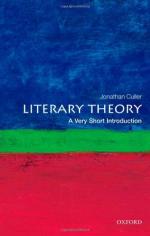
|
| Name: _________________________ | Period: ___________________ |
This test consists of 15 multiple choice questions and 5 short answer questions.
Multiple Choice Questions
1. Thanks to cultural studies, what has happened to many previously discarded works?
(a) All of these.
(b) They were debated in schools.
(c) They were revamped.
(d) They were rediscovered.
2. According to Chapter 4, what is Hamlet about on a deeper level?
(a) The collapse of Elizabethan England.
(b) Family betrayal.
(c) The downfall of Rome.
(d) The greed of lineage.
3. What is the purpose of literary theory, according to "What is Theory?"
(a) To prove writing wrong.
(b) To reflect on ideas.
(c) To tame the masses.
(d) To transcend ignorant readers.
4. According to Chapter 4, what effect should the words have on the reader?
(a) A subliminal message.
(b) An effect on imagination.
(c) All of these.
(d) An emotional response.
5. According to theorists, how many people are required to obtain multiple interpretations of a text?
(a) Ten.
(b) Three.
(c) One.
(d) Two.
6. In the West, most theorists believe language allows for _____________.
(a) Brotherhood.
(b) Communication.
(c) Intimacy.
(d) Thought expression.
7. Theory rarely results in __________, according to Culler.
(a) A strong guess.
(b) A good theory.
(c) A close estimation.
(d) A definitive answer.
8. According to Chapter 3, which author continues to stand the test of time?
(a) Ben Jonson.
(b) Shakespeare.
(c) Marlowe.
(d) Dan Brown.
9. What is the significance of published literature, according to Culler?
(a) A book is declared worthy to read.
(b) A book is available for the masses.
(c) A book is paid for.
(d) It can catapult an author to fame.
10. In Chapter 3, from what form of culture is pop culture developed?
(a) Mainstream.
(b) Foreign.
(c) Combative.
(d) Underground.
11. What was Richard Rorty's area of expertise?
(a) Philosophy.
(b) Science.
(c) Literature.
(d) Math.
12. What is no longer demanded of cultural scholars?
(a) "Slow reading."
(b) "Tight reading."
(c) "Close reading."
(d) "Back reading."
13. Who is Ferdinand de Saussure?
(a) A Russian leader.
(b) An American journalist.
(c) A Swiss linguist.
(d) A German professor.
14. In Chapter 2, it is suggested that British literature worked to do what among the classes?
(a) Create harmony.
(b) Invoke shame.
(c) Create a divide.
(d) Instill a stronger sense of class.
15. What literary approach starts with a preconceived notion before offering supporting evidence to payoff that idea?
(a) All of these.
(b) Poetics.
(c) Hermeneutics.
(d) Justification.
Short Answer Questions
1. What idea did Rousseau help to develop?
2. What type of study is approached clinically?
3. Who created the theory of interpellation?
4. What nationality was Rousseau?
5. What did Derrida discover in Rousseau's work?
|
This section contains 382 words (approx. 2 pages at 300 words per page) |

|




